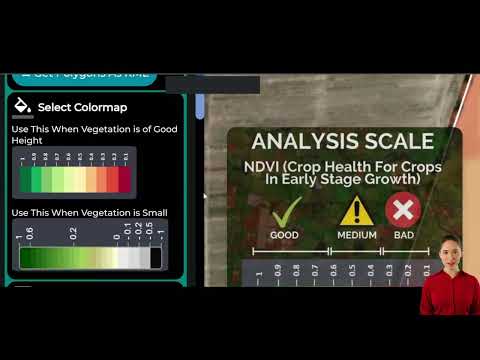
In today’s rapidly evolving agricultural landscape, farmers and agricultural companies are constantly seeking innovative ways to optimize crop yield, reduce losses, and make data-driven decisions. Enter Farmonaut’s powerful web application for satellite monitoring – a game-changing tool that’s transforming the way we approach farming and crop management.
🌱 Introduction to Farmonaut’s Satellite Monitoring Platform
Farmonaut’s web app is a robust platform designed to provide farmers with comprehensive crop analytics through satellite monitoring. This innovative tool offers a wide range of functionalities that make it an invaluable asset for modern agriculture. By leveraging free satellite imagery for farms, Farmonaut enables users to gain deep insights into their fields’ health and performance.
The platform showcases multiple submitted locations, each with its own set of unique and dedicated analytics. This allows farmers to monitor multiple fields simultaneously, providing a holistic view of their entire operation.
🔍 Detailed Location Analysis: Unveiling Field Health
Let’s dive into a specific location to understand the depth of insights Farmonaut provides. We’ll examine data from April 14, 2022, as an example of how the platform offers a snapshot of field conditions at any given time.
Plantation Presence Check
The first step in analyzing a location is determining if there’s any plantation present. This is easily accomplished by using the ETCI (Enhanced True Color Imagery) button, which displays a true-colored RGB image of the location.
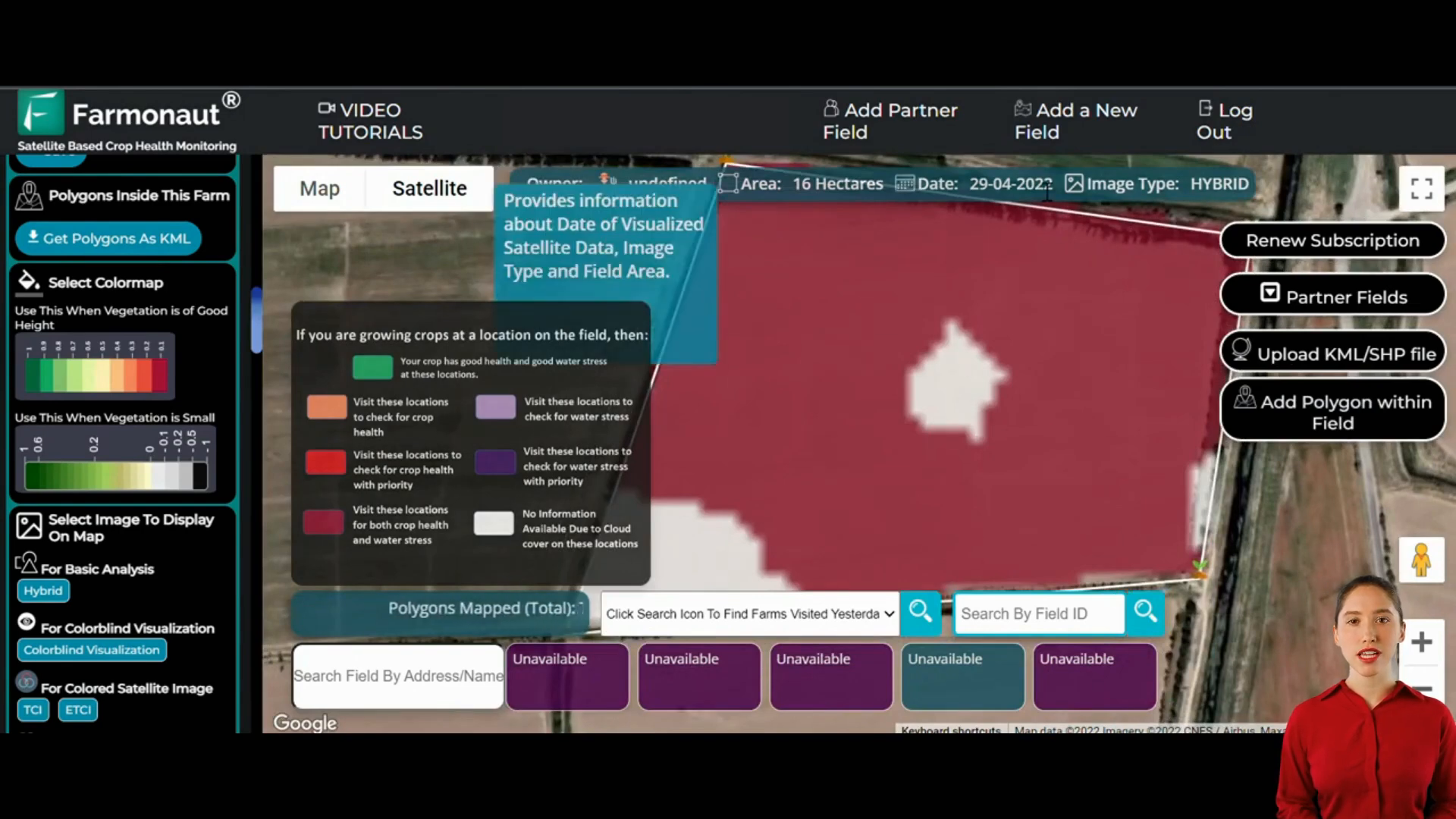
Upon viewing the image, we can confirm the presence of plantation, although the crop height may not be particularly impressive at this early stage. This initial assessment sets the stage for more in-depth analysis.
Comprehensive Crop Performance Analysis
Farmonaut’s platform offers a multitude of metrics and analytical tools to assess crop performance in detail. These tools allow farmers to:
- Assess crop growth rate
- Understand overall crop performance
- Identify patches infested by pests or diseases
This comprehensive analysis empowers farmers to make informed decisions, optimizing crop health and yield. The platform’s crop analytics capabilities are particularly valuable for early detection of issues, allowing for timely interventions.
💧 Irrigation Metrics: Ensuring Optimal Water Management
Water management is crucial for crop success, and Farmonaut’s platform provides detailed irrigation metrics to help farmers optimize their water usage. The platform evaluates various factors including:
- Water stress levels within the plantation
- Soil moisture levels
- Evapotranspiration rate
These parameters play a vital role in ensuring proper hydration of crops and maintaining soil health. Let’s explore each of these metrics in more detail:
Water Stress Analysis
The platform uses the Normalized Difference Water Index (NDWI) to measure water stress levels within the crop. This provides an overview of the plantation, identifying areas that may require additional irrigation or adjustments in water management practices.
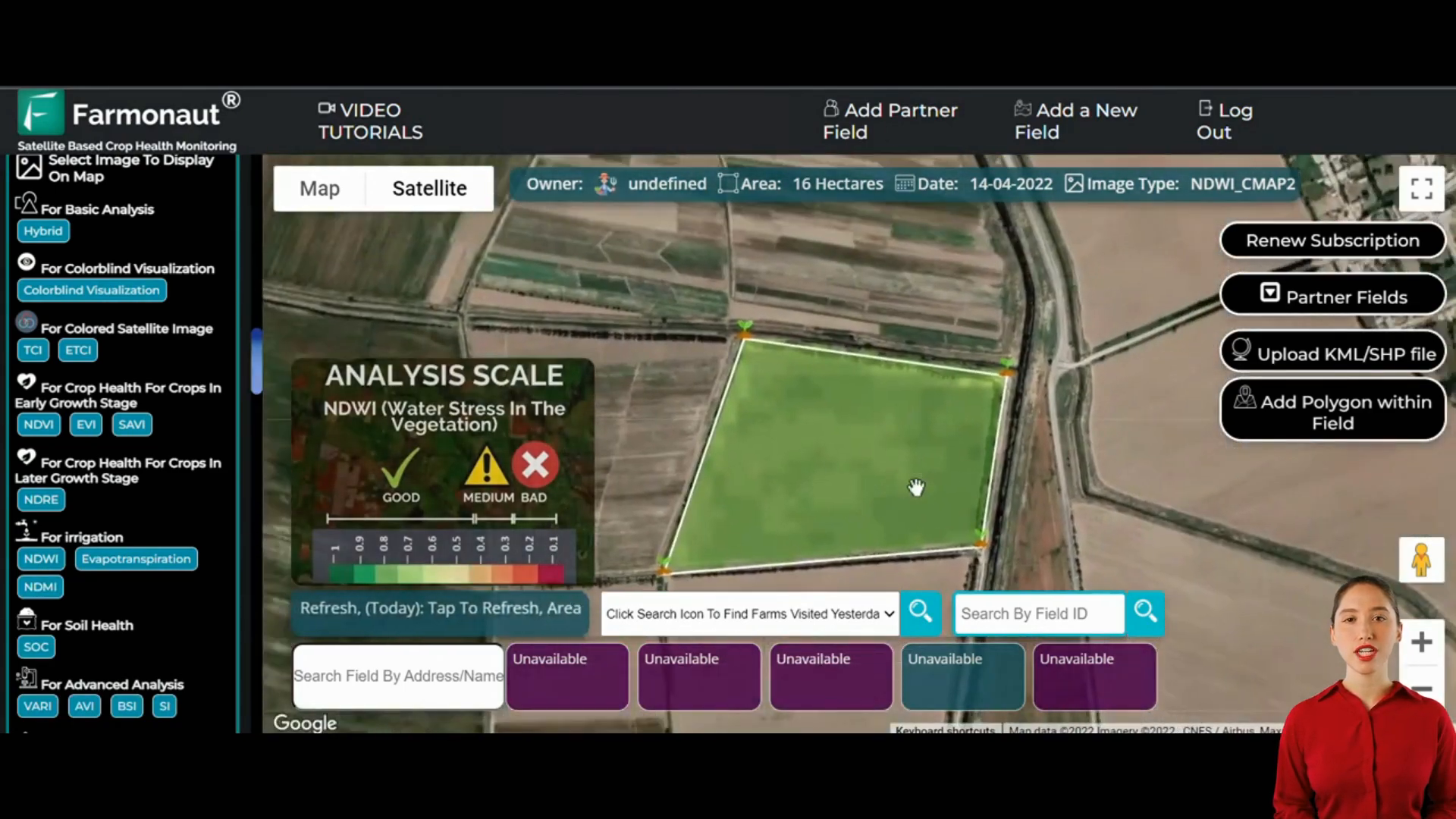
Soil Moisture Evaluation
The Normalized Difference Moisture Index (NDMI) data is used to examine soil moisture levels across different locations within the plantation. This is particularly useful for identifying specific areas with poor soil moisture, even if overall water stress isn’t prominent.
Evapotranspiration Rate
The platform also provides data on the evapotranspiration rate, showing how much water is evaporating and transpiring from the plants. This helps in understanding water consumption patterns, ensuring that irrigation schedules are optimized to meet the plant’s needs without overwatering or underwatering.

🌿 Soil Health Analysis: The Foundation of Crop Success
Soil health is fundamental to crop growth and yield. Farmonaut’s platform provides valuable insights into soil conditions, helping farmers maintain optimal soil health.
Soil Organic Carbon Data
The platform offers access to soil organic carbon (SOC) data, which is crucial for understanding soil fertility and health. This data becomes particularly useful when the crop is harvested and the soil is entirely exposed to the atmosphere.
By examining SOC levels, farmers can:
- Identify areas where organic carbon content has declined
- Prioritize soil testing in specific locations
- Determine the right nutrients needed to replenish the soil
This allows farmers to restart the cultivation cycle with a well-restored soil profile, setting the stage for healthy crop growth in the next season.

🌊 Waterlogging Risk Assessment: Preventing Crop Damage
Waterlogging can be detrimental to crop health, and Farmonaut’s platform helps identify areas prone to this issue using digital elevation model data. This feature is particularly useful in the event of heavy rainfall or excessive irrigation.
By pinpointing locations where water may accumulate, farmers can take preemptive measures such as:
- Installing proper drainage systems
- Adding pumps to mitigate waterlogging
- Adjusting irrigation practices in prone areas
This proactive approach helps preserve crop health and prevent yield losses due to waterlogging.
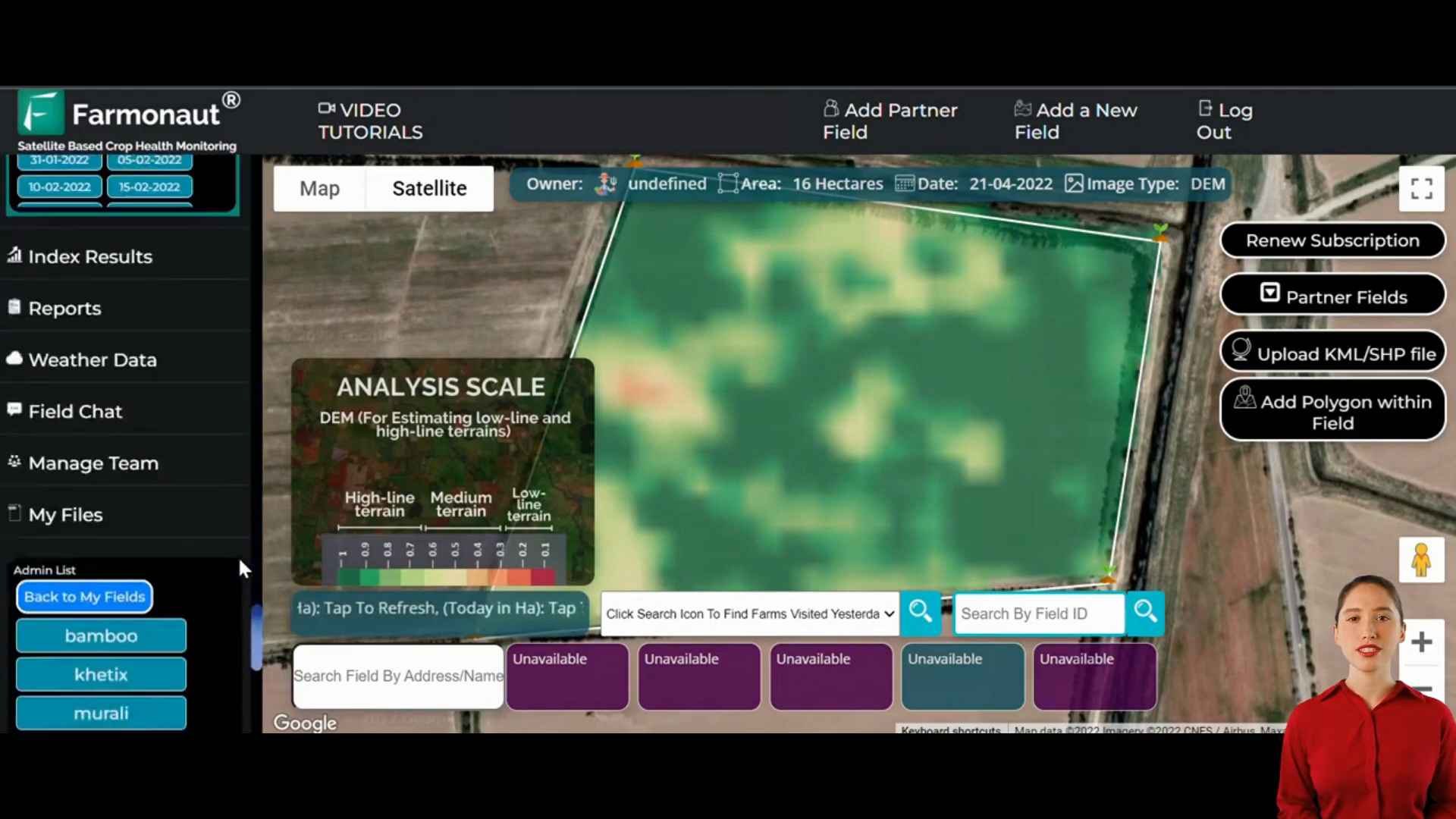
📊 Advanced Crop Performance Indices: Diving Deeper into Crop Health
Farmonaut’s platform utilizes a variety of advanced indices to provide in-depth insights into crop health and performance. These indices are particularly useful for different stages of crop growth and varying levels of canopy development.
Early Growth Stage Indices
For crops in the early stages of growth, the platform uses several indices:
- NDVI (Normalized Difference Vegetation Index)
- EVI (Enhanced Vegetation Index)
- SAVI (Soil Adjusted Vegetation Index)
These indices provide insights into crop performance by displaying images encoded in specific color maps. For example, NDVI uses a color range from dark red to dark green, each color corresponding to a different growth level:
- Light orange to light green: Medium growth
- Light orange to dark red: Poor growth
- Light to dark green: Good growth
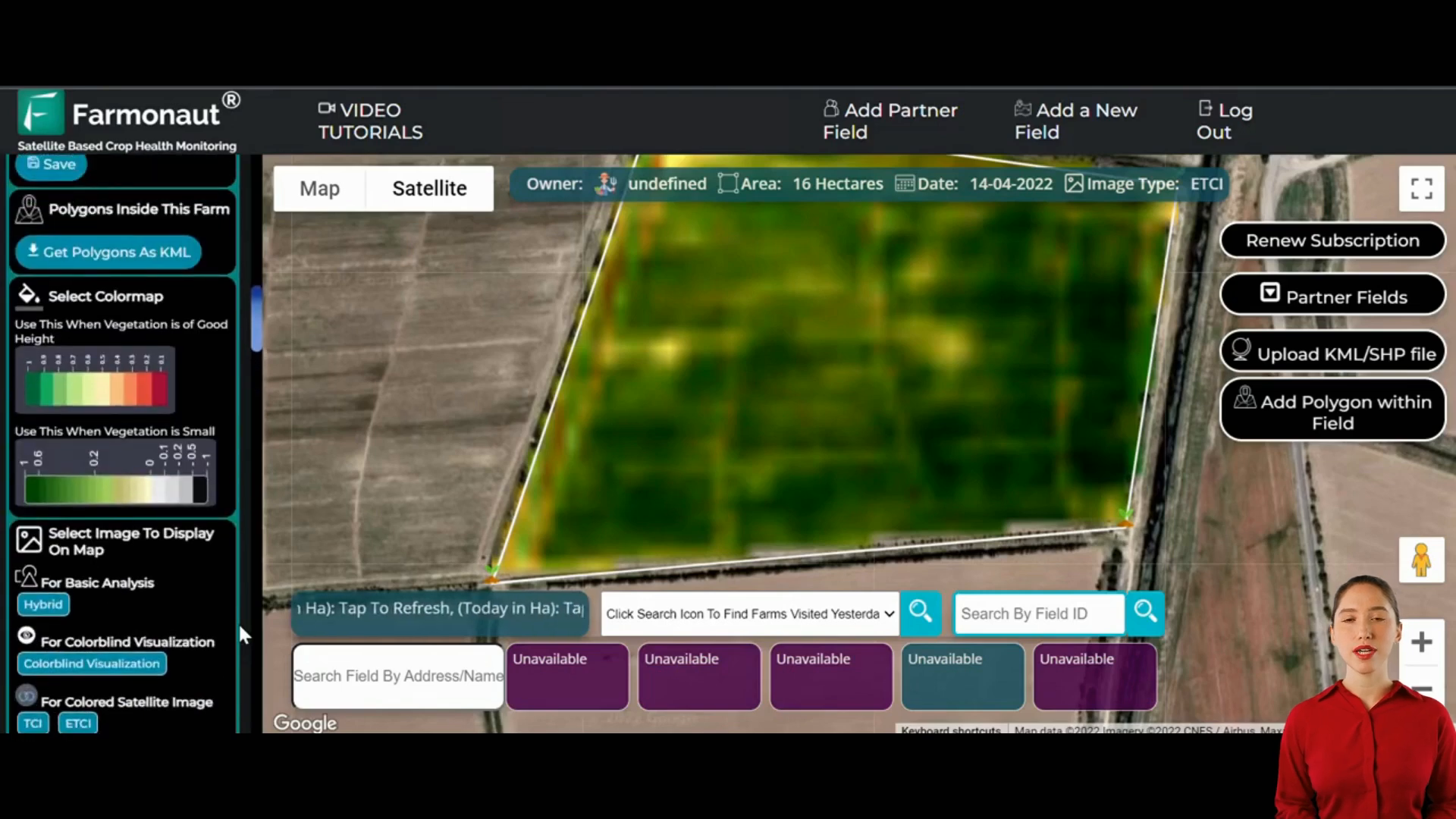
Advanced Canopy Analysis
As crops progress beyond the early growth stage and achieve a certain minimum height, the platform switches to using the NDRE (Normalized Difference Red Edge) index. NDRE is tailored to assess crop health throughout the canopy, even penetrating deeper layers.
This index can reveal issues such as:
- Nutrient deficiencies
- Disease presence in bottom layers of the canopy
- Overall canopy health and density
NDRE becomes invaluable for continued health assessments as crops mature, providing insights that might not be apparent from surface-level observations.
🕰️ Historical Data and Time Series Analysis: Informed Decision-Making
Farmonaut’s platform doesn’t just provide current data – it also offers access to historical data, enabling comprehensive analyses and informed decision-making.
Regular Updates and Historical Data Access
The platform is regularly updated with new satellite data, which appears in the “Select Image Date” section. Users receive notifications when new data is available. Additionally, historical data from 2018 to 2021 is accessible, supporting long-term trend analysis and planning.
Image Comparison for Growth Tracking
Farmers can compare images from different dates to track crop growth over time. This feature is particularly useful for identifying significant changes and allowing for timely interventions.
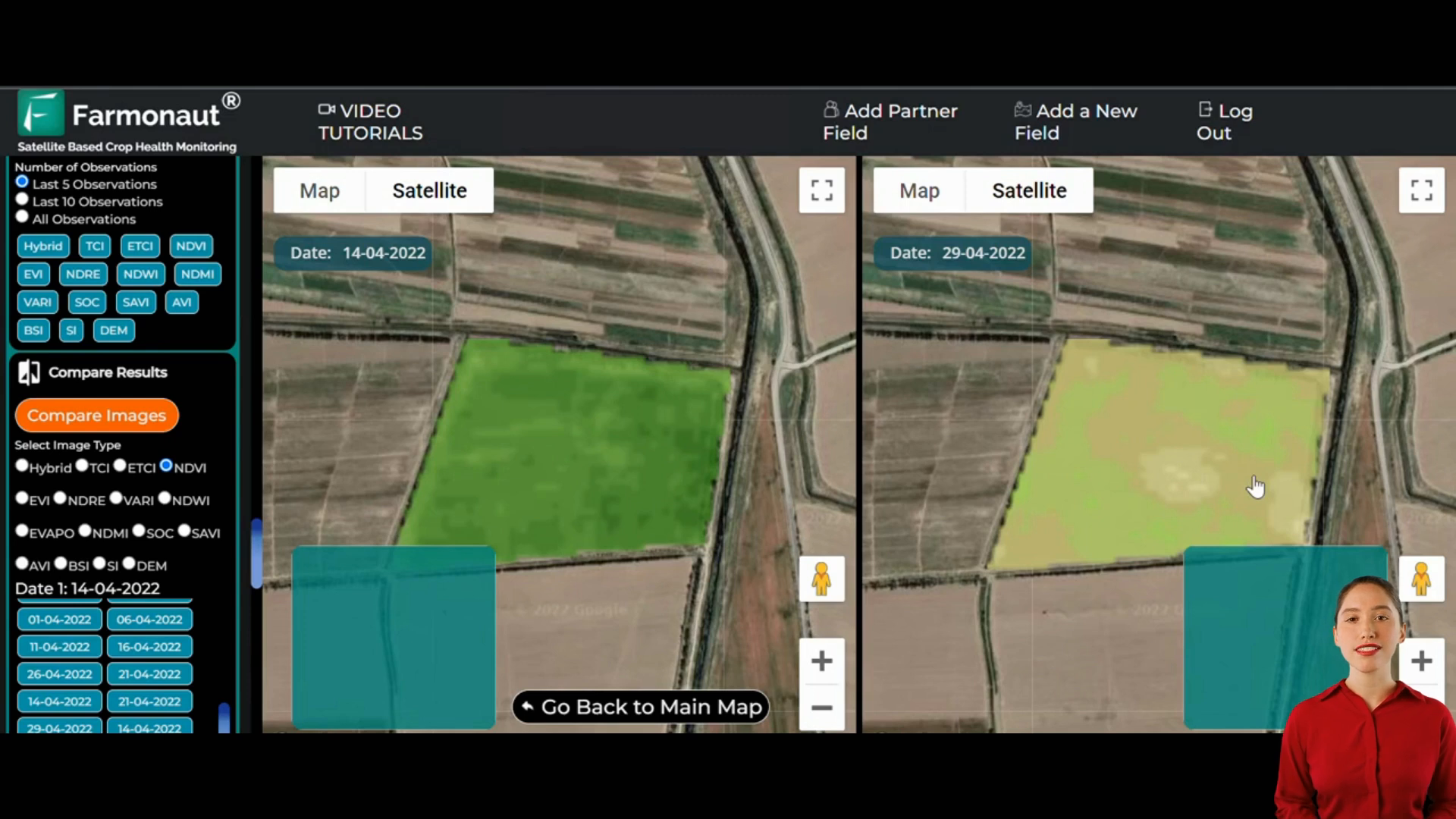
Time Series Analysis
The platform includes features like the Index Results section, providing performance insights and growth anomalies over time. Time series analyses assist in understanding growth dynamics and planning for future seasons.
👁️ Visual Comparison Tool: Spotting Subtle Changes
Farmonaut’s “Compare Images” feature allows users to visually examine farm development by selecting different dates. This side-by-side comparison helps spot subtle changes in crop health, enabling early detection of issues and timely interventions.
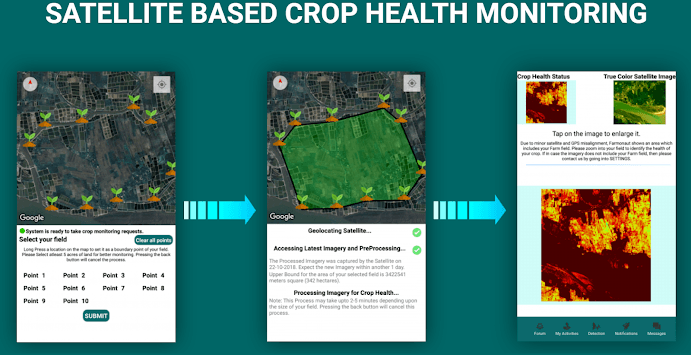
❓ FAQ: Frequently Asked Questions about Farmonaut’s Web App
Q: How often is the satellite data updated?
A: The platform is regularly updated with new satellite data. Users receive notifications when new data is available for their monitored fields.
Q: Can I access historical data for my fields?
A: Yes, Farmonaut provides access to historical data from 2018 onwards, allowing for comprehensive long-term analyses.
Q: What types of crop health issues can the platform detect?
A: The platform can help identify various issues including water stress, nutrient deficiencies, pest infestations, and diseases, depending on the specific indices and data used.
Q: Is the platform suitable for all types of crops?
A: While the platform is versatile, its effectiveness may vary depending on the crop type. It’s best suited for field crops with significant canopy coverage.
Q: How can I interpret the different color maps used in the indices?
A: Each index uses a specific color map to represent different levels of crop health or stress. Generally, greener colors indicate better health, while reds often indicate stress or poor growth. The platform provides detailed legends for each index.
🎯 Conclusion: Empowering Farmers with Advanced Crop Analytics
Farmonaut’s web app for satellite monitoring offers a comprehensive suite of tools and analytics for modern crop management. From detailed growth metrics to irrigation analysis and soil health evaluation, the platform optimizes crop performance through real-time updates, historical data, and intuitive analysis tools.
By leveraging free agriculture satellite imagery and advanced crop analytics, Farmonaut empowers farmers to make data-driven decisions, ensuring healthy, high-yielding crops. This innovative approach to farming monitor and field health monitoring is revolutionizing agriculture, helping farmers mitigate risks, optimize resources, and maximize yields.
As we continue to face global challenges in food production and sustainability, tools like Farmonaut’s web app will play an increasingly crucial role in shaping the future of agriculture. By embracing this technology, farmers and agricultural stakeholders can stay ahead of the curve, ensuring food security and agricultural prosperity for generations to come.
